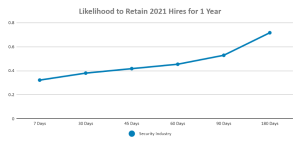Retention and the First 90 Days
This article appeared in the February 2023 issue of The Californian.
The labor market has been, arguably, one of the biggest frustrations for security professionals over the past few years. The data proves it.
National hiring rates during a six month period (industry agnostic) are trending up, although still slightly below pre-pandemic levels. As of September 2022, the labor participation rate across the country was an average .6% higher than the previous year, but 1.0% lower than pre-pandemic participation rates in December 2019 (63.3%).
When looking at sample data from TEAM Software by WorkWave, active employees within the security industry show a 2.2% average monthly increase for the 12-month period of October 2021 through September 2022.
Despite hiring significantly more than the national average, the net sum of workers in the security industry aren’t substantially increasing due to the amount of turnover. In order to maintain an average annual headcount of 100 employees, for example, a security company must hire 108 applicants a year. As such, retention remains a high priority.
The 90-day retention milestone
In the security industry, new hires are 53% more likely to retain for one year if they reach 90 days of employment.
Some tactics industry leaders are including to increase retention, especially within the first 90 days, include:
Job posting transparency
One of the biggest reasons new hires churn fast is because their job responsibilities don’t match expectations. Communicate responsibilities throughout the hiring process, from the job posting onward. Then, continue to reinforce expectations through accurate job instructions tied to your software solution. This should include digital resources on the job profile that can be easily shared or accessed, text fields for specific notes and job-specific documents, bulletins, events or links.
Flexible work
Flexibility is a growing demand in applicant pools. The nature of physical security means there will always be a need for on-site, shift-based work. However, introducing flexibility into your employees’ experience where you can – like self-scheduling, where employees can offer their shifts to others without needing to involve a schedule or supervisor – can improve employee engagement and retention while simultaneously reducing high-cost expenses, like overtime. Others can pick up open work and mark themselves as available if they want to pick up additional hours. This tactic can also alleviate some administrative scheduling tasks from your managers, while still ensuring contract coverage.
Earned wage access
Earned wage access provides a way for employees to receive payment for hours worked, without having to wait for the next pay cycle to process. One of the biggest barriers employees face in succeeding at a field job is the reliability of their transportation. Sometimes, the gap between paychecks impacts a worker’s ability to afford transit, let alone living expenses.
This can make a big difference in employee financial wellness even during times of economic stability. In times of uncertainty that bring rising fuel prices, energy crises and more unrest, access to wages on demand can make a critical difference to employee wellbeing and workforce engagement.
Incentive programs
Employee referral programs exist as an incentive for an existing employee to refer a potential new employee to your hiring staff. If the candidate is hired, the existing employee receives a benefit, typically of monetary value. Many companies have programs like this in place, yet don’t see referrals as a leading hiring source. The reason why could be because the policy is out of sight, out of mind. Make sure your human resources staff are sharing incentive programs like employee referrals consistently and often. As you’re developing these programs, build them with retention in mind. Build in agreements that both the new hire and referring employee need to remain employed for a certain period of time – 90 days, at least – to qualify for the benefit.
Any one of these tactics, or a combination of all, can help encourage retention to and past the 90-day mark, when the odds of longer-term retention increase. For more labor trend data you can use to help support your retention strategies, access TEAM Software by WorkWave’s recent data report, an analysis of recent trends and forecasts for the year ahead.

